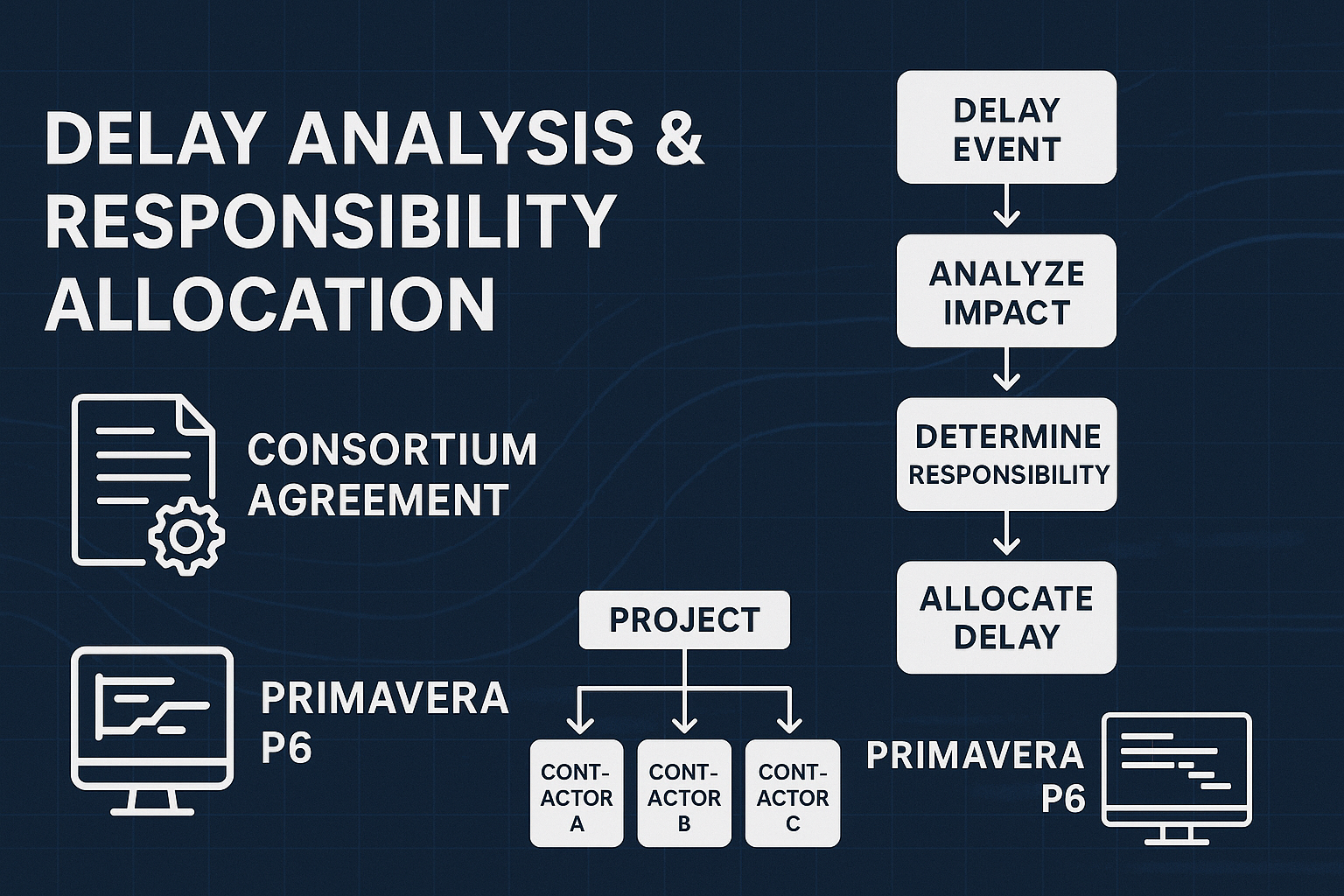Mastering Delay Analysis & Responsibility Allocation in Consortium Projects: Best Practices from the Field
Introduction:
In today’s complex infrastructure and energy sectors, projects are increasingly delivered through consortium models—where multiple contractors unite to leverage specialized expertise, share risks, and scale efficiently. However, when delays emerge, especially in high-value and schedule-sensitive environments, the challenge of assigning responsibility becomes a legal, technical, and relational tightrope.
At ALVID Consulting, we recently supported a high-profile consortium project grappling with delay attribution under intricate contractual and technical interdependencies. Without naming specifics, the lessons learned offer valuable insight into best practices for managing delay analysis and responsibility allocation—especially in shared environments like Primavera P6 databases.

1. Clear Responsibility Matrix in Consortium Agreements
One of the most overlooked components in joint ventures and consortium frameworks is the absence of a clearly articulated responsibility matrix. While the overarching contract may outline scopes, real-life project execution often sees blurred lines, especially where interfaces between parties overlap.
Best Practice:
Develop a Responsibility Assignment Matrix (RAM) that is integrated into the consortium agreement and updated throughout the project lifecycle.
Clearly delineate:
Scope boundaries per contractor
Shared interface responsibilities
Authority and approval workflows
Change management triggers per scope segment
2. Use of Shared Primavera P6 Environments: Structure with Discipline
A shared Primavera P6 database can be a powerful tool for schedule transparency and collaboration—if governed correctly. In one recent case, lack of naming conventions, schedule logic governance, and baseline integrity created confusion and undermined delay analysis credibility.
Best Practice:
Define a Project Scheduling Governance Protocol at kick-off.
Key elements:
Lock baseline schedules only after joint sign-off
Enforce strict naming conventions (WBS, activities, resources)
Restrict global changes and require approval logs for schedule updates
Define roles: scheduler of record, schedule integrator, reviewer
3. Delay Analysis Methodology: One Size Doesn’t Fit All
Too often, parties default to simplistic methodologies (e.g., Impacted As-Planned) without regard for what is contractually permissible or technically defendable. In the aforementioned case, disagreement over methodology (Window Analysis vs. Time Impact Analysis) created legal gridlock.
Best Practice:
Align on a Delay Analysis Protocol at contract stage, ideally referenced in the consortium agreement.
Match method to project and data maturity:
Early-stage: Time Impact Analysis
Mid-project: Windows or Contemporaneous Analysis
Post-completion: As-Built vs. As-Planned or Collapsed As-Built
Ensure each delay event has supporting contemporaneous records:
Site instructions
RFIs
NCRs
Progress meeting minutes
4. Neutral Delay Review Committee: A Consortium Game-Changer
Delays in consortiums often become “he said, she said” battles that erode trust. In the example we supported, a major breakthrough came through establishing a neutral Delay Review Committee, composed of internal and third-party experts to adjudicate based on shared data and defined criteria.
Best Practice:
Form a Delay Review Committee early, with clear Terms of Reference.
Build decisions on:
Pre-agreed delay protocols
Integrated project schedules
Verified site documentation
Consensus on impact thresholds (e.g., critical path shifts, float consumption)
5. Documentation & Narrative: The Soul of Defensibility
Technical schedules are necessary, but without contextual narratives and clearly attributed evidence trails, they rarely stand up in dispute resolution. Delay impact narratives written in vague or biased language can undercut even the most sophisticated P6 models.
Best Practice:
Prepare regular Delay Event Reports (DERs)—objective, timestamped, and cross-referenced to the program.
Effective DERs include:
Description of the event and its root cause
Parties involved and their respective roles
Delay quantification with impacted activities
Linked supporting documentation (RFIs, logs, correspondence)
Suggested mitigation or resolution actions
Conclusion: Engineering Clarity into Complexity
At ALVID Consulting, we believe that delay disputes don’t arise simply from missed dates—they arise from missed clarity. Whether through contractual gaps, technical mismanagement, or misaligned tools, projects can only succeed when both accountability and transparency are engineered from day one.
In the age of digital collaboration, shared scheduling platforms like Primavera P6, coupled with a disciplined consortium approach, can transform fragmented teams into high-performing partnerships.
If your consortium-led project is facing delay attribution challenges, or you’re looking to proactively engineer defensibility into your schedule, ALVID Consulting is ready to bring clarity to complexity.

